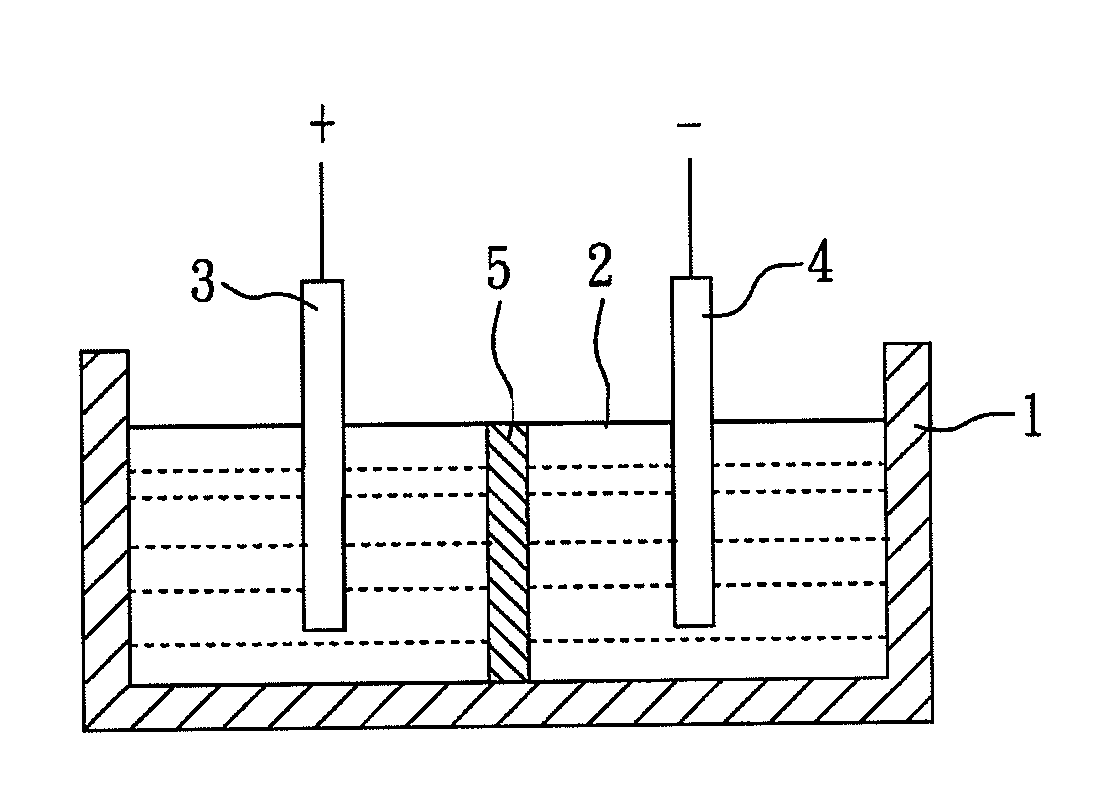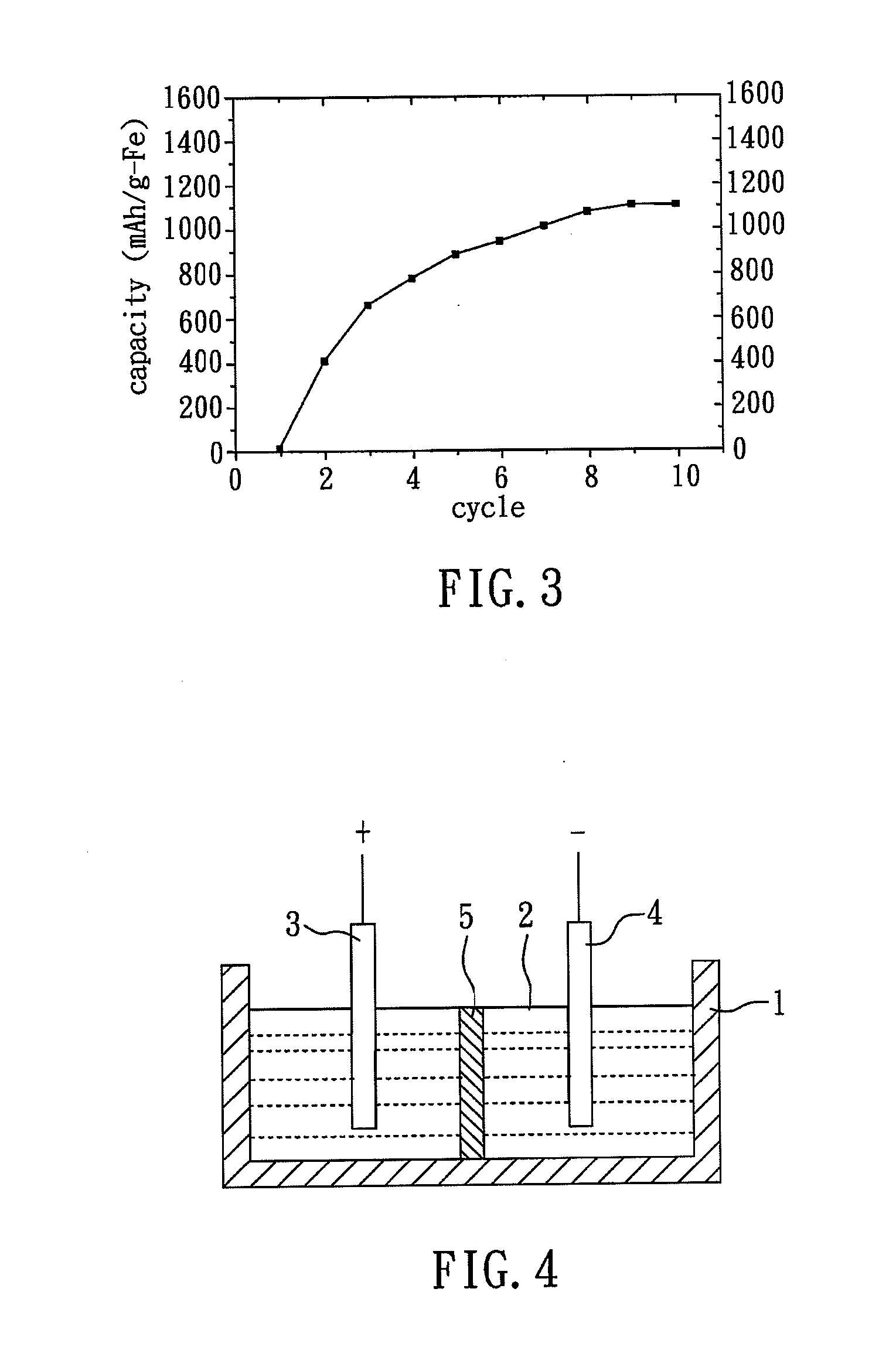Composite material for negative electrode, method for fabricating the same and electrochemical device using the same
a technology of composite materials and negative electrodes, which is applied in the direction of non-metal conductors, secondary cell details, cell components, etc., can solve the problems that the energy density and power density of such entire batteries cannot meet the requirements, and the capacity of iron electrodes fabricated by these conventional methods is poor, etc., to achieve excellent market potency, improve charge/discharge characteristics and capacity, and simple and low-cost process
- Summary
- Abstract
- Description
- Claims
- Application Information
AI Technical Summary
Benefits of technology
Problems solved by technology
Method used
Image
Examples
example 1
[0031]FeSO4.7H2O (2.3352 g) and Fe2(SO4)3.7H2O (8.94 g) are prepared into an aqueous solution, and then nitrogen gas is introduced therein for 5 minutes. Subsequently, sodium hydroxide is added therein, and the pH value of the aqueous solution is adjusted to 11-12 with continuous stirring for 30 minutes to generate about 2 g of Fe3O4. Next, Fe3O4 is separated magnetically therefrom and washed many times, followed by the addition of CuSO4.5H2O (1.834 g, as a conductivity improver), Na2S.9H2O (0.09 g) and PTFE (0.22 g, as a binder), to obtain a slurry (i.e. a composite material for a negative electrode). Finally, the slurry is coated on a current collector net (i.e. a negative electrode substrate) to form a negative electrode coating layer, thus obtaining a negative electrode.
[0032]After the negative electrode prepared by the present example is charged, copper sulfate (as a conductivity improver) in the negative electrode will be reduced into nano copper and surround reduced iron micr...
example 2
[0034]FeSO4.7H2O (2.3352 g) and Fe2(SO4)3.7H2O (8.94 g) are prepared into an aqueous solution, and then nitrogen gas is introduced therein for 5 minutes. Subsequently, sodium hydroxide is added therein, and the pH value of the aqueous solution is adjusted to about 12 with continuous stirring for 30 minutes to generate about 2 g of Fe3O4. Next, Fe3O4 is separated magnetically therefrom and washed many times, followed by the addition of Cu (0.467 g, as a conductivity improver), Na2S.9H2O (0.09 g) and PTFE (0.22 g, as a binder), to obtain a slurry (i.e. a composite material for a negative electrode). Finally, the slurry is coated on a current collector net (i.e. a negative electrode substrate) to form a negative electrode coating layer, thus obtaining a negative electrode.
[0035]In the present example, the diameter of the iron oxide particles (i.e. Fe3O4 particles) is a range of from about 20 nm to about 100 nm, and the weight ratio of the iron oxide particles (i.e. Fe3O4 particles) to ...
example 3
[0036]FeSO4.7H2O (2.3352 g) and Fe2(SO4)3.7H2O (8.94 g) are prepared into an aqueous solution, and then nitrogen gas is introduced therein for 5 minutes. Subsequently, sodium hydroxide is added therein, and the pH value of the aqueous solution is adjusted to about 12 with continuous stirring for 30 minutes to generate about 2 g of Fe3O4. Next, CuSO4.5H2O (1.834 g) is added therein, and the pH value of the aqueous solution is adjusted to about 12, thereby generating Cu(OH)2 from CuSO4.5H2O. Then, powders of Cu(OH)2 and Fe3O4 mixed uniformly are collected by suction filtration, followed by baking. Subsequently, the baked powders are mixed uniformly with Na2S.9H2O (0.09 g) and PTFE (0.22 g, as a binder) to obtain a slurry (i.e. a composite material for a negative electrode). Finally, the slurry is coated on a current collector net (i.e. a negative electrode substrate) to form a negative electrode coating layer, thus obtaining a negative electrode.
[0037]After the negative electrode prep...
PUM
| Property | Measurement | Unit |
|---|---|---|
| diameter | aaaaa | aaaaa |
| weight ratio | aaaaa | aaaaa |
| diameter | aaaaa | aaaaa |
Abstract
Description
Claims
Application Information
 Login to View More
Login to View More - R&D
- Intellectual Property
- Life Sciences
- Materials
- Tech Scout
- Unparalleled Data Quality
- Higher Quality Content
- 60% Fewer Hallucinations
Browse by: Latest US Patents, China's latest patents, Technical Efficacy Thesaurus, Application Domain, Technology Topic, Popular Technical Reports.
© 2025 PatSnap. All rights reserved.Legal|Privacy policy|Modern Slavery Act Transparency Statement|Sitemap|About US| Contact US: help@patsnap.com



